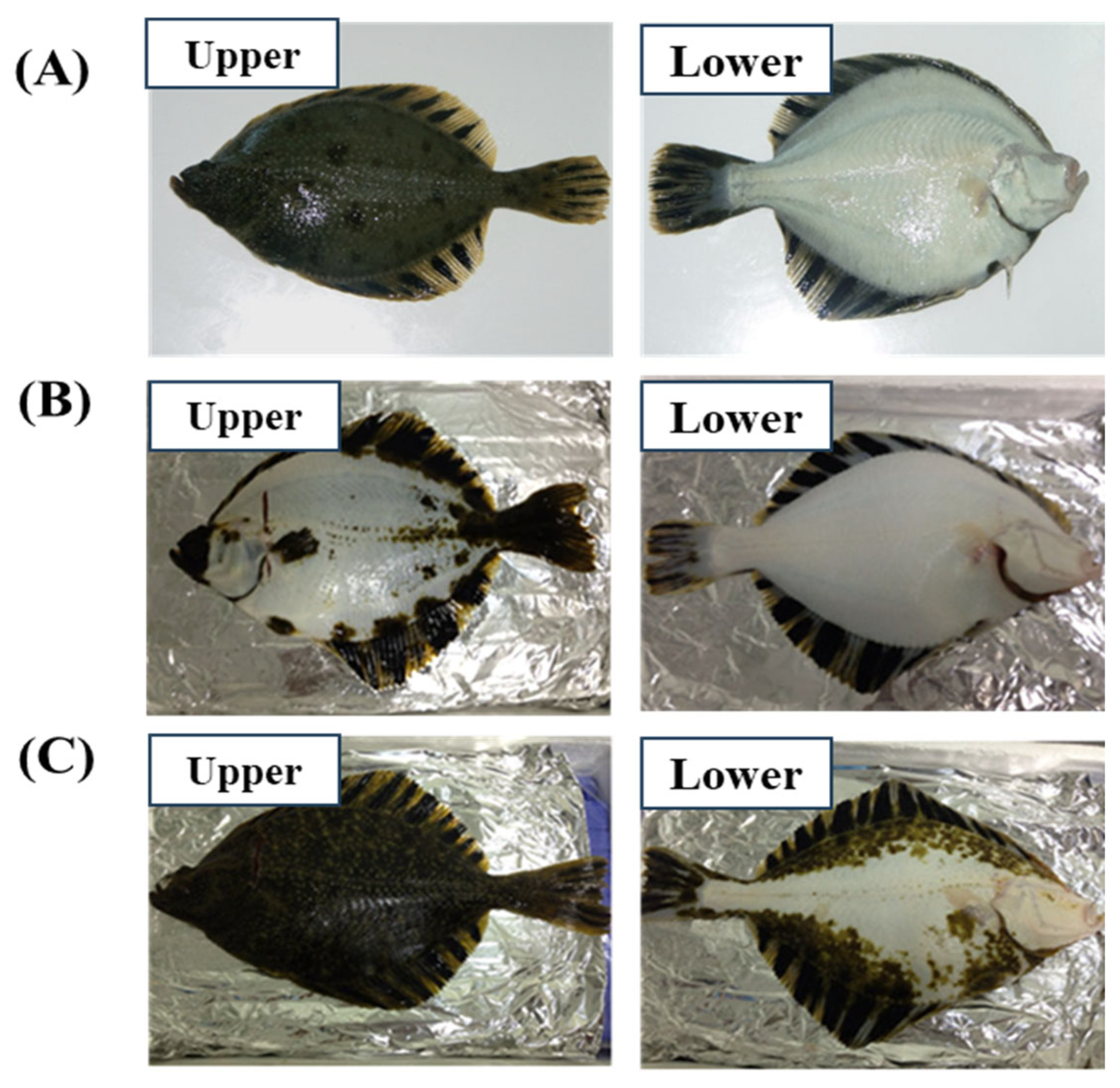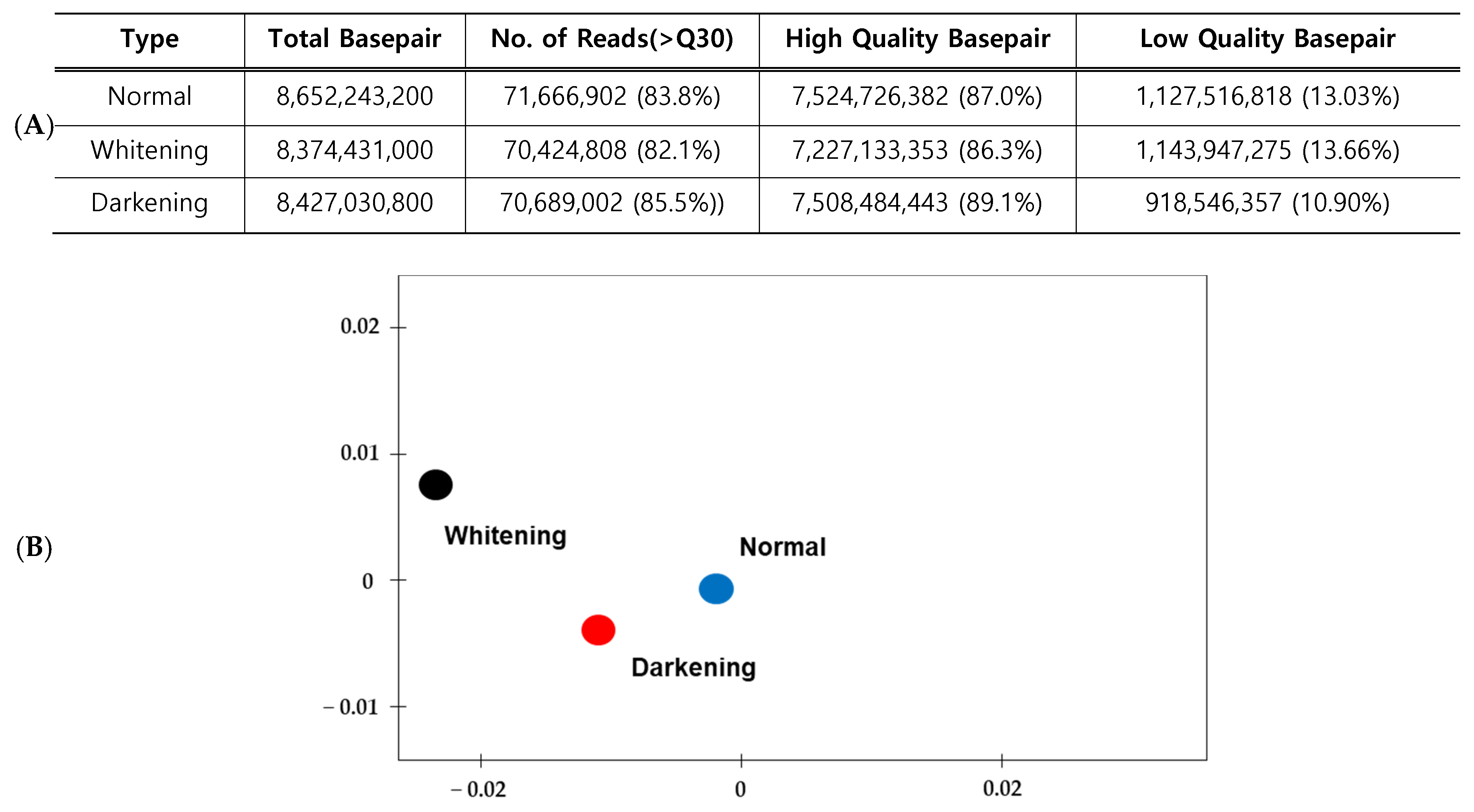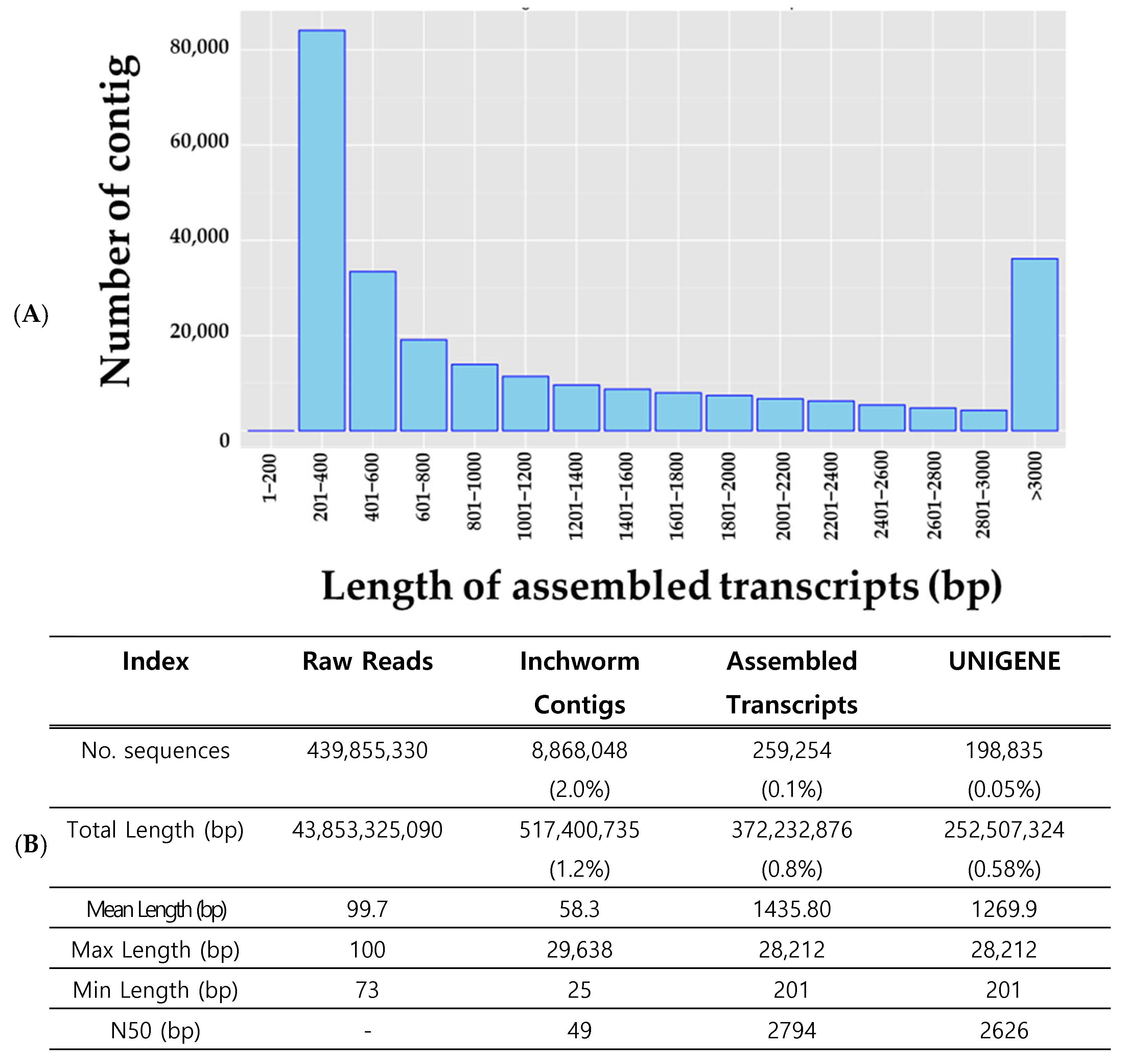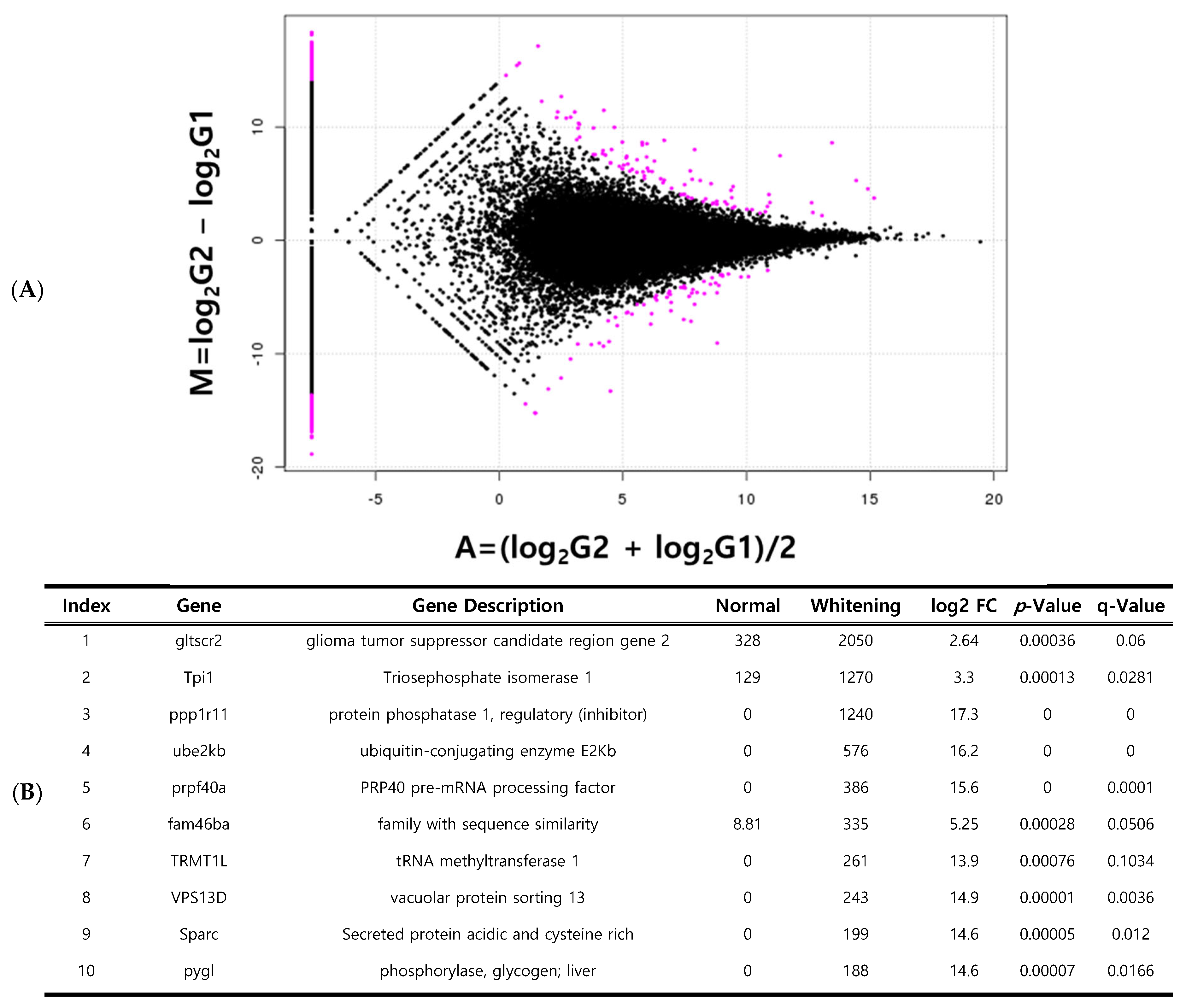Analysis of Gene Expression Related to Pigmentation Variation in the Brain Tissue of Starry Flounder (Platichthys stellatus) Using RNA-Seq
Abstract
1. Introduction
2. Materials and Methods
2.1. Sample Collection
2.2. RNA Extraction and Library Preparation
2.3. NGS Data Analysis: Filtering, Assembly, and Clustering
2.4. Analysis of Differentially Expressed Genes (DEGs)
2.5. Functional Analysis. Gene Ontology (GO), KEGG Pathway Analysis
3. Results
3.1. RNA-Seq De Novo Assembly
3.2. DEGs Analysis
3.3. Commonly Expressed Genes in Brain Tissue
3.4. Differential Gene Expression Analysis
3.5. Gene Ontology and KEGG Pathway Analysis
4. Discussion
5. Conclusions
Supplementary Materials
Author Contributions
Funding
Institution Review Board Statement
Informed Consent statement
Data Availability Statement
Conflicts of Interest
References
- Cho, J.-H.; Hamidoghli, A.; Hur, S.-W.; Lee, B.-J.; Lee, S.; Kim, K.-W.; Lee, S. Growth, Nutrient Deposition, Plasma Metabolites, and Innate Immunity Are Associated with Feeding Rate in Juvenile Starry Flounder (Platichthys stellatus). Animals 2024, 14, 3127. [Google Scholar] [CrossRef]
- Jung, H.-C.; Kim, J.-H.; Kang, J.-C. Toxic Impact of Dietary Cadmium on Bioaccumulation, Growth, Hematological Parameters, Plasma Components, and Antioxidant Responses in Starry Flounder (Platichthys stellatus). Fishes 2024, 9, 59. [Google Scholar] [CrossRef]
- An, H.S.; Nam, M.M.; Myeong, J.I.; An, C.M. Genetic diversity and differentiation of the Korean starry flounder (Platichthys stellatus) between and within cultured stocks and wild populations inferred from microsatellite DNA analysis. Mol. Biol. Rep. 2014, 41, 7281–7292. [Google Scholar] [CrossRef]
- Nakhawa, A.D.; Tandel, S.; Chellapan, A.; V, A.K.; Kumar, R. First Record of Hyperpigmentation in a Unicorn Cod, Bregmaceros Mcclellandi Thompson, 1840 (Gadiformes: Bregmacerotidae), From the North-west Coast of India. Thalass. Int. J. Mar. Sci. 2021, 37, 683–688. [Google Scholar] [CrossRef]
- Kang, D.-Y.; Kim, H.-C. Functional relation of agouti signaling proteins (ASIPs) to pigmentation and color change in the starry flounder, Platichthys stellatus. Comp. Biochem. Physiol. Part A Mol. Integr. Physiol. 2024, 291, 111524. [Google Scholar] [CrossRef] [PubMed]
- Bolker, J.A.; Hill, C.R. Pigmentation abnormalities in flatfish: A literature review. J. Fish Biol. 2000, 57, 1–20. [Google Scholar]
- Fernández-Díaz, C.; Yúfera, M. Pseudoalbinism in Senegal sole (Solea senegalensis): Implications for aquaculture. Aquaculture 1997, 154, 141–150. [Google Scholar]
- Li, H.; Chen, C.; Wang, Z.; Wang, K.; Li, Y.; Wang, W. Pattern of new gene origination in a special fish lineage, the flatfishes. Genes 2021, 12, 1819. [Google Scholar] [CrossRef] [PubMed]
- Kim, T.M.; Jang, H.S.; Park, J.Y.; bin Lee, H.; Lim, H.K. Effects of Environmental Factors on the Eye Direction in Juvenile Starry Flounder Platichthys stellatus. Korean J. Fish. Aquat. Sci. 2024, 57, 448–458. [Google Scholar]
- Kim, J.; Lee, S.H.; Park, C. Neuroendocrine regulation of pigmentation in fish under aquaculture stress. Aquaculture 2022, 555, 738217. [Google Scholar]
- Martínez, C.; López, M.; García, P. Neural and hormonal control of stress-induced pigmentation in teleosts. Comp. Biochem. Physiol. A Mol. Integr. Physiol. 2021, 256, 110940. [Google Scholar]
- Piredda, R.; Mottola, A.; Cipriano, G.; Carlucci, R.; Ciccarese, G.; Di Pinto, A. Next Generation Sequencing (NGS) approach applied to species identification in mixed processed seafood products. Food Control 2022, 133, 108590. [Google Scholar] [CrossRef]
- Satam, H.; Joshi, K.; Mangrolia, U.; Waghoo, S.; Zaidi, G.; Rawool, S.; Thakare, R.P.; Banday, S.; Mishra, A.K.; Das, G. Next-generation sequencing technology: Current trends and advancements. Biology 2023, 12, 997. [Google Scholar] [CrossRef]
- Pereira, R.; Oliveira, J.; Sousa, M. Bioinformatics and computational tools for next-generation sequencing analysis in clinical genetics. J. Clin. Med. 2020, 9, 132. [Google Scholar] [CrossRef]
- Arteche-López, A.; Ávila-Fernández, A.; Romero, R.; Riveiro-Álvarez, R.; López-Martínez, M.; Giménez-Pardo, A.; Vélez-Monsalve, C.; Gallego-Merlo, J.; García-Vara, I.; Almoguera, B. Sanger sequencing is no longer always necessary based on a single-center validation of 1109 NGS variants in 825 clinical exomes. Sci. Rep. 2021, 11, 5697. [Google Scholar] [CrossRef]
- Surányi, B.B.; Zwirzitz, B.; Mohácsi-Farkas, C.; Engelhardt, T.; Domig, K.J. Comparing the efficacy of MALDI-TOF MS and sequencing-based identification techniques (Sanger and NGS) to monitor the microbial community of irrigation water. Microorganisms 2023, 11, 287. [Google Scholar] [CrossRef]
- Saeidian, A.H.; Youssefian, L.; Vahidnezhad, H.; Uitto, J. Research techniques made simple: Whole-transcriptome sequencing by RNA-seq for diagnosis of monogenic disorders. J. Investig. Dermatol. 2020, 140, 1117–1126.e1111. [Google Scholar] [CrossRef] [PubMed]
- Negi, A.; Shukla, A.; Jaiswar, A.; Shrinet, J.; Jasrotia, R.S. Applications and challenges of microarray and RNA-sequencing. Bioinformatics 2022, 91–103. [Google Scholar] [CrossRef]
- Grabherr, M.G.; Haas, B.J.; Yassour, M.; Levin, J.Z.; Thompson, D.A.; Amit, I.; Adiconis, X.; Fan, L.; Raychowdhury, R.; Zeng, Q. Trinity: Reconstructing a full-length transcriptome without a genome from RNA-Seq data. Nat. Biotechnol. 2011, 29, 644. [Google Scholar] [CrossRef] [PubMed]
- Haas, B.J.; Papanicolaou, A.; Yassour, M.; Grabherr, M.; Blood, P.D.; Bowden, J.; Couger, M.B.; Eccles, D.; Li, B.; Lieber, M. De novo transcript sequence reconstruction from RNA-seq using the Trinity platform for reference generation and analysis. Nat. Protoc. 2013, 8, 1494–1512. [Google Scholar] [CrossRef] [PubMed]
- Pertea, G.; Huang, X.; Liang, F.; Antonescu, V.; Sultana, R.; Karamycheva, S.; Lee, Y.; White, J.; Cheung, F.; Parvizi, B. TIGR Gene Indices clustering tools (TGICL): A software system for fast clustering of large EST datasets. Bioinformatics 2003, 19, 651–652. [Google Scholar] [CrossRef]
- Huang, X.; Madan, A. CAP3: A DNA sequence assembly program. Genome Res. 1999, 9, 868–877. [Google Scholar] [CrossRef]
- Sun, J.; Nishiyama, T.; Shimizu, K.; Kadota, K. TCC: An R package for comparing tag count data with robust normalization strategies. BMC Bioinform. 2013, 14, 1–14. [Google Scholar] [CrossRef]
- Anders, S.; Huber, W. Differential expression analysis for sequence count data. Nat. Preced. 2010, 1. [Google Scholar] [CrossRef]
- Ryu, Y.-A.; Choi, C.Y.; Kang, J.-C.; Kim, J.-H. Effects on lethal concentration 50% hematological parameters and plasma components of Starry flounder, Platichthys stellatus exposed to hexavalent chromium. Environ. Toxicol. Pharmacol. 2024, 113, 104610. [Google Scholar] [CrossRef]
- Min, B.H.; Park, M.S.; Myeong, J.-l. Stress responses of starry flounder, Platichthys stellatus (Pallas) following water temperature rise. J. Environ. Biol. 2015, 36, 1057. [Google Scholar]
- Lee, H.B.; Yoon, J.H.; Park, J.Y.; Lee, I.Y.; Lim, H.K. A comparison of the physiological responses to heat stress of juvenile and adult starry flounder (Platichthys stellatus). Isr. J. Aquac. Bamidgeh 2021, 73, 1–15. [Google Scholar] [CrossRef]
- Lee, H.; Chung, J.S.; Yoon, J.; Park, J.Y.; Lim, H.K. Understanding Heat-Associated Adult Platichthys stellatus Mortality: Differential Transcriptome Analysis of Juvenile and Adult Starry Flounder Liver under Heat Stress. Aquac. Res. 2024, 2024, 9980817. [Google Scholar] [CrossRef]
- Blandon, I.R.; DiBona, E.; Battenhouse, A.; Vargas, S.; Mace, C.; Seemann, F. Analysis of the Skin and Brain Transcriptome of Normally Pigmented and Pseudo-whitening Southern Flounder (Paralichthys lethostigma) Juveniles to Study the Molecular Mechanisms of Hypopigmentation and Its Implications for Species Survival in the Natural Environment. Int. J. Mol. Sci. 2024, 25, 7775. [Google Scholar]
- Svitačová, K.; Slavík, O.; Horký, P. Pigmentation potentially influences fish welfare in aquaculture. Appl. Anim. Behav. Sci. 2023, 262, 105903. [Google Scholar] [CrossRef]
- Devi, N.K.; Kumar, A.T.; Balasubramanian, T. Pigment deficiency correction in captive clown fish, amphiprion ocellaris using different carotenoid sources. J. FisheriesSciences.Com 2016, 10, 4. [Google Scholar]
- Schaerlinger, B.; Żarski, D. Evaluation and improvements of egg and larval quality in percid fishes. In Biology and Culture of Percid Fishes: Principles and Practices; Springer: Dordrecht, The Netherlands, 2015; pp. 193–223. [Google Scholar]
- Bernáth, G.; Csenki, Z.; Bokor, Z.; Várkonyi, L.; Molnár, J.; Szabó, T.; Staszny, Á.; Ferincz, Á.; Szabó, K.; Urbányi, B. The effects of different preservation methods on ide (Leuciscus idus) sperm and the longevity of sperm movement. Cryobiology 2018, 81, 125–131. [Google Scholar] [CrossRef]
- Fan, Y.; Li, H.; Miguez-Macho, G. Global patterns of groundwater table depth. Science 2013, 339, 940–943. [Google Scholar] [CrossRef] [PubMed]
- Yamaguchi, Y.; Hearing, V.J. Physiological factors that regulate skin pigmentation. Biofactors 2010, 36, 193–199. [Google Scholar] [CrossRef]
- Matheson, S.; Larjava, H.; Häkkinen, L. Distinctive localization and function for lumican, fibromodulin and decorin to regulate collagen fibril organization in periodontal tissues. J. Periodontal Res. 2005, 40, 312–324. [Google Scholar] [CrossRef] [PubMed]
- Torres Núñez, E. Sparc (Osteonectin): New Insight into the Function and Regulation = Sparc (Osteonectin): Nuevos Conocimientos Sobre sus Funciones y Regulación. Ph.D. Thesis, Universitat de Barcelona, Barcelona, Spain, 2014. [Google Scholar]
- Li, C.-C.; Dong, H.-J.; Wang, P.; Meng, W.; Chi, X.-J.; Han, S.-C.; Ning, S.; Wang, C.; Wang, X.-J. Cellular protein GLTSCR2: A valuable target for the development of broad-spectrum antivirals. Antivir. Res. 2017, 142, 1–11. [Google Scholar] [CrossRef]
- Bjørgen, H.; Hansen, H.Ø.; Saevareid, O.; Edvardsen, R.B.; Øvergård, A.-C. Melanisation in Salmonid Skeletal Muscle: A Review. J. Fish Dis. 2024, 47, e14063. [Google Scholar] [CrossRef] [PubMed]
- Kang, D.-Y.; Lee, J.-H.; Kim, W.-J.; Kim, H.-C. Morphological specificity in cultured starry flounder Platichthys stellatus reared in artificial facility. Fish. Aquat. Sci. 2012, 15, 117–123. [Google Scholar] [CrossRef]
- Leclercq, E.; Taylor, J.F.; Migaud, H. Morphological skin color changes in teleosts. Fish Fish. 2010, 11, 159–193. [Google Scholar] [CrossRef]







| Index | Gene | Normal | White | Dark | Index | Gene | Normal | White | Dark |
|---|---|---|---|---|---|---|---|---|---|
| 1 | ribosomal protein L31 | 971.8 | 1268.5 | 1557.7 | 19 | ribosomal protein S7 | 810.2 | 1082.6 | 1230.6 |
| 2 | ribosomal protein L10a | 701.7 | 916.6 | 1052.7 | 20 | neuraminidase 1 | 787.4 | 1341.0 | 1594.8 |
| 3 | 60S ribosomal protein L32 | 847.4 | 1161.0 | 1158.6 | 21 | ribosomal protein S8 | 746.3 | 1074.2 | 1255.8 |
| 4 | ribosomal protein L34 | 694.0 | 902.6 | 1069.6 | 22 | muscle actin OlMA1 | 897.9 | 1099.7 | 1326.0 |
| 5 | ribosomal protein L37a | 1330.8 | 1385.3 | 1353.4 | 23 | beta thymosin-like protein | 916.7 | 897.5 | 1144.7 |
| 6 | 60S ribosomal protein L27a | 747.7 | 990.4 | 1107.8 | 24 | nascent polypeptide | 881.7 | 1128.1 | 1144.1 |
| 7 | 40S ribosomal protein S3a | 820.2 | 1015.7 | 1191.3 | 25 | synaptosome protein 25a | 772.3 | 1499.61 | 1528.7 |
| 8 | ribosomal protein L17 | 829.7 | 1323.3 | 1482.9 | 26 | fatty acid-binding protein 2 | 863.9 | 1012.7 | 1347.5 |
| 9 | ribosomal protein S24 | 818.6 | 1221.0 | 1484.5 | 27 | fructose-bisphosphate aldolase | 1121.7 | 1131.2 | 1025.0 |
| 10 | ribosomal protein L36a | 1138.6 | 1524.8 | 1749.1 | 28 | S100 calcium-binding protein | 2066.8 | 2523.3 | 3675.8 |
| 11 | fatty acid-binding protein 7 | 1247.5 | 1431.7 | 1626.8 | 29 | elongation factor 1 alpha | 771.2 | 1037.4 | 1310.4 |
| 12 | uncharacterized | 1005.7 | 1016.7 | 1184.8 | 30 | 60S ribosomal protein L4-A | 656.9 | 839.7 | 1030.8 |
| 13 | Ependymin-1 | 1231.1 | 928.4 | 1836.1 | 31 | 60S ribosomal protein L23a | 1010.1 | 1328.8 | 1539.9 |
| 14 | beta-synuclein | 991.0 | 1161.6 | 1081.3 | 32 | ribosomal protein S23 | 1000.5 | 1267.6 | 1362.9 |
| 15 | ribosomal protein L12 | 799.7 | 1112.4 | 1224.4 | 33 | 40S ribosomal protein S15a | 811.4 | 1039.8 | 1069.9 |
| 16 | ribosomal protein L9 | 733.5 | 973.6 | 1100.5 | 34 | ribosomal protein S13 | 734.8 | 951.0 | 1065.4 |
| 17 | ribosomal protein S27 | 1188.7 | 1759.2 | 1899.7 | 35 | ribosomal protein L30 | 657.3 | 886.6 | 981.9 |
| 18 | stathmin 1b | 1535.1 | 1644.4 | 1566.2 |
| Index | Pathway | List of Genes | p-Value |
|---|---|---|---|
| Whitening | ErbB signaling | CAMK2G, RPS6KB2, MAPK9, MAPK10, CAMK2A | 0.025 |
| GnRH signaling | ADCY8, CAMK2G, MAPK9, MAPK10, CAMK2A | 0.036 | |
| Wnt signaling | CTBP1, CAMK2G, MAPK9, MAPK10, CAMK2A, TCF7L2 | 0.043 | |
| Arrhythmogenic right ventricular cardiomyopathy | CACNA2D1, DMD, DAG1, TCF7L2 | 0.073 | |
| Spliceosome | RBM22, EIF4A3, SF3B1, PUF60, SF3B3 | 0.077 | |
| Darkening | Spliceosome | RBM22, EIF4A3, SF3B1, SNRPA1, CHERP, SNRNP27, PUF60, SF3B3, PRPF40A | 0.001 |
| N-Glycan biosynthesis | MAN2A2, MAN2A1, MAN1B1 | 0.085 |
Disclaimer/Publisher’s Note: The statements, opinions and data contained in all publications are solely those of the individual author(s) and contributor(s) and not of MDPI and/or the editor(s). MDPI and/or the editor(s) disclaim responsibility for any injury to people or property resulting from any ideas, methods, instructions or products referred to in the content. |
© 2025 by the authors. Licensee MDPI, Basel, Switzerland. This article is an open access article distributed under the terms and conditions of the Creative Commons Attribution (CC BY) license (https://creativecommons.org/licenses/by/4.0/).
Share and Cite
Hwang, J.; Kang, D.-Y. Analysis of Gene Expression Related to Pigmentation Variation in the Brain Tissue of Starry Flounder (Platichthys stellatus) Using RNA-Seq. J. Mar. Sci. Eng. 2025, 13, 2190. https://doi.org/10.3390/jmse13112190
Hwang J, Kang D-Y. Analysis of Gene Expression Related to Pigmentation Variation in the Brain Tissue of Starry Flounder (Platichthys stellatus) Using RNA-Seq. Journal of Marine Science and Engineering. 2025; 13(11):2190. https://doi.org/10.3390/jmse13112190
Chicago/Turabian StyleHwang, Jinik, and Duk-Young Kang. 2025. "Analysis of Gene Expression Related to Pigmentation Variation in the Brain Tissue of Starry Flounder (Platichthys stellatus) Using RNA-Seq" Journal of Marine Science and Engineering 13, no. 11: 2190. https://doi.org/10.3390/jmse13112190
APA StyleHwang, J., & Kang, D.-Y. (2025). Analysis of Gene Expression Related to Pigmentation Variation in the Brain Tissue of Starry Flounder (Platichthys stellatus) Using RNA-Seq. Journal of Marine Science and Engineering, 13(11), 2190. https://doi.org/10.3390/jmse13112190




